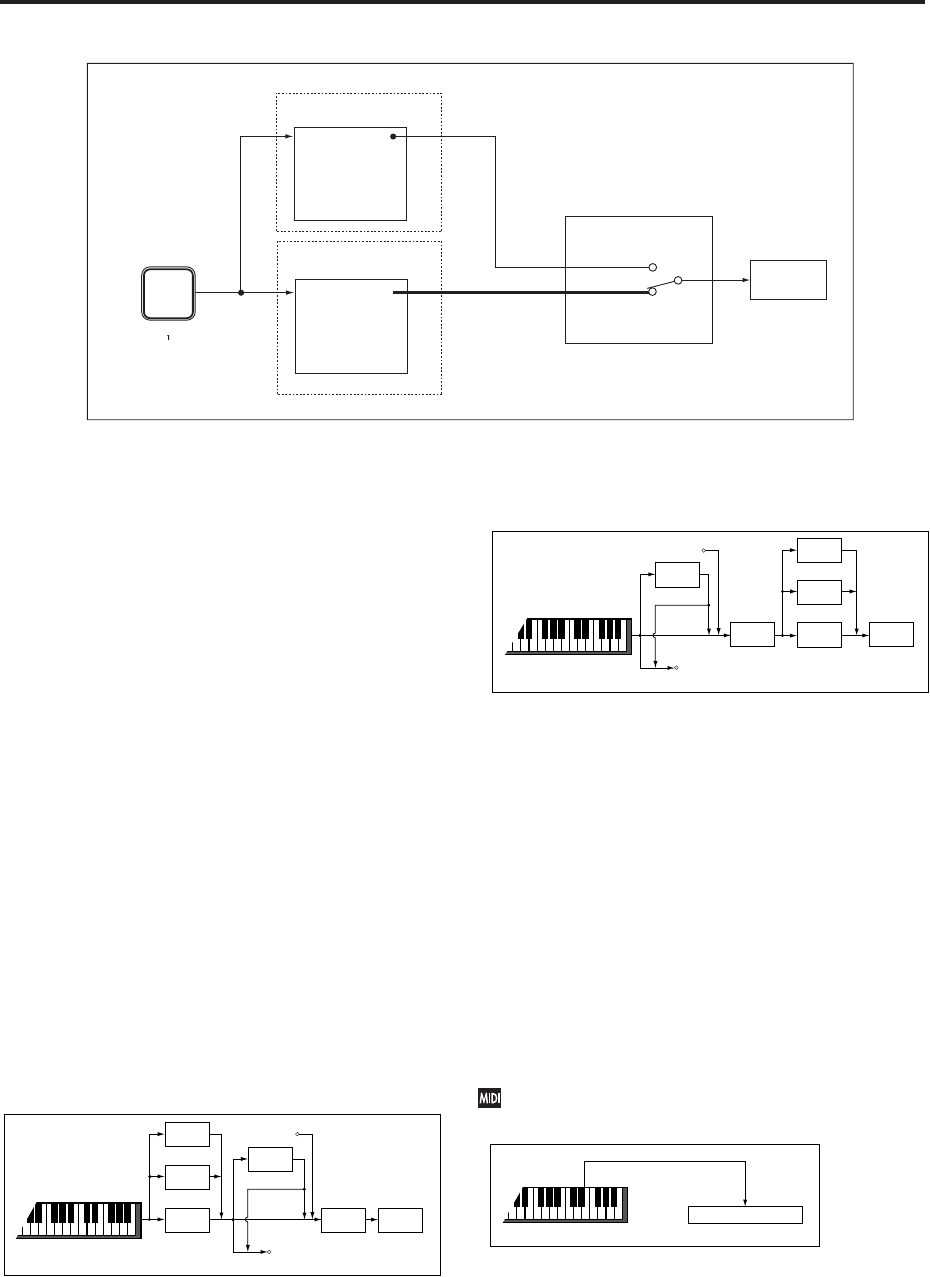
Global mode
652
RESET CONTROLS button: Local Control does not
change the way that the Control Surface interacts with
RESET CONTROLS. For instance, if Local Control is
Off, holding RESET CONTROLS and moving a knob
will still reset the knob.
Other Control Surface buttons: the CONTROL
ASSIGN buttons, the MIXER KNOBS button, and the
SOLO button are not affected by Local Control.
Convert Position [PreMIDI, PostMIDI]
This setting specifies the location at which the
Transpose, Velocity Curve, and After Touch Curve
settings will be applied. This setting will affect the
MIDI data that is transmitted and received, and the
data that is recorded on the internal sequencer.
When using the OASYS’s keyboard to play the internal
tone generator, the Transpose, Velocity Curve, and
After Touch Curve settings will always take effect
regardless of this setting.
PreMIDI: Velocity Curve, After Touch Curve, and
Transpose will be applied to the data that is
transmitted from the OASYS’s keyboard.
This means that the Velocity Curve, After Touch Curve,
and Transpose settings will affect the data that is
transmitted from MIDI OUT when the OASYS’s
keyboard is played, and the data that is recorded on
the internal sequencer.
MIDI data received from MIDI IN or the data played
back by the internal sequencer will not be affected.
PostMIDI: Velocity Curve, After Touch Curve, and
Transpose will be applied to data before it enters the
tone generator.
This means that the Velocity Curve, After Touch Curve,
and Transpose settings will affect the data that is sent
to the internal tone generator when you play the
OASYS’s keyboard, when the internal sequencer is
played back, or when data is received from MIDI IN.
This setting will not affect the data that is transmitted
from MIDI OUT or recorded on the internal sequencer
when you play the OASYS’s keyboard or play back the
sequence.
Note Receive (Note Receive Filter) [All, Even, Odd]
This setting specifies whether even-numbered, odd-
numbered, or all note numbers will be sounded when
note data is received from the OASYS’s keyboard or
from an external MIDI device. By connecting the
OASYS to another OASYS and setting one instrument
to Even and the other to Odd, you can effectively
double the polyphony by dividing the notes between
the two instruments.
All: All note numbers will be received. Normally you
will leave this set to All.
Even: Even-numbered notes (C, D, E, F#, G#, A#) will
sound.
Odd: Odd-numbered notes (C#, D#, F, G, A, B) will
sound.
This setting has no effect on the MIDI data that is
received.
MIDI Clock
MIDI Clock (MIDI Clock Source) [Internal, External
MIDI, Auto]
Use this setting to synchronize the OASYS’s KARMA
function and internal sequencer with an external MIDI
device (e.g., sequencer or rhythm machine).
Internal: The KARMA function and the internal
sequencer will operate according to the internal clock.
Velocity
Curve
Aftertouch
Curve
Tone
generator
Note number
change
Play
MIDI IN
MIDI OUT
Record
Sequencer
Transpose
Scale
Velocity
Curve
Aftertouch
Curve
Tone
generator
Play
MIDI IN
MIDI OUT
Record
Sequencer
Transpose
Scale
Pitch change
ODD
EVEN
MIDI OUT
MIDI IN
Another OASYS
Pad1
Pads
MIDI Output
Pads MIDI Out
Pad CC/Note
Chord Notes
1: C3 / 127
2: C4 / 100
3: E4 / 102
4: G4 / 105
5: B4 / 064
6: Off
7: Off
8: Off
Pads Chord
(Settings for each Program, Combination, Song)
Controller MIDI CC Assign
(Global P2: 2–1c setting)
PAD1
Pad1: MIDI CC#110
Pad2: MIDI CC#111
Pad3: MIDI CC#112
Pad4: MIDI CC#113
Pad5: MIDI CC#114
Pad6: MIDI CC#115
Pad7: MIDI Note#60
Pad8: Off
C3, C4, E4, G4, B4
Note On & Off
CC#110


















